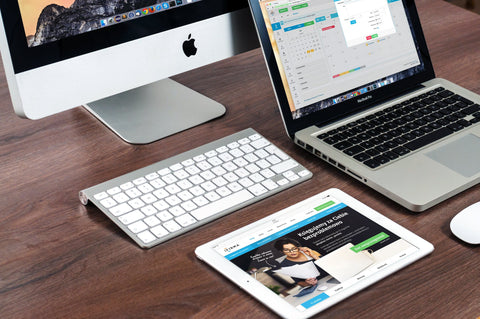Smart Offices: An Inside Look at the Tech That's Revolutionising Workspaces
Welcome to the world of Smart Office Technology where workspaces are being transformed with the help of cutting-edge tech. Smart Offices are the future, providing numerous benefits such as increased efficiency, cost savings, and improved collaboration.
With the integration of various devices and software solutions, Smart Office Technology can handle a wide range of tasks that were previously done manually, making work easier, faster, and more accurate.

What is Smart Office Technology?
Smart Office Technology refers to the integration of technology and automation solutions into office spaces to improve efficiency, productivity, and collaboration amongst employees. It involves using a variety of hardware and software systems to create an interconnected network of devices and applications.
The use of Smart Office Technology allows for a range of benefits, including improved communication, more streamlined processes, and enhanced data collection and analysis. It can also create a more comfortable and convenient working environment for employees.
Some examples of Smart Office Technology solutions include:
|
Technology Solution |
Description |
|
Smart Lighting |
Lighting systems that adjust based on natural light levels and can be controlled through a mobile app or voice commands. |
|
Smart Thermostats |
Thermostats that can be programmed to adjust temperature based on occupancy and can be controlled remotely through a mobile app. |
|
Virtual Assistants |
Voice-activated assistants that can answer questions, set reminders, and control various devices throughout the office. |
|
Collaboration Tools |
Software platforms that allow for remote collaboration, file sharing, and video conferencing. |
Overall, Smart Office Technology is transforming traditional workspaces into more modern and efficient environments, and is becoming increasingly important for businesses to stay competitive in today's digital age.
The Benefits of Smart Office Technology

The benefits of incorporating Smart Office Technology into your workspace are numerous and significant. Here are just a few:
- Increased productivity: Smart Office Technology can automate repetitive tasks, allowing employees to focus on more complex and creative work. This leads to increased productivity and efficiency.
- Time savings: Automation of tasks and processes leads to time savings that can be reallocated towards other projects or tasks.
- Improved collaboration: Smart Office Technology can facilitate better collaboration between coworkers by providing seamless communication channels and shared workspaces.
- Cost savings: By automating tasks and processes, companies can reduce the need for manual labor and therefore reduce labor costs. Additionally, Smart Office Technology can help reduce energy consumption and other operational costs.
According to a study by PwC, companies that embrace Smart Office Technology see a 10-20% increase in productivity and a 30% reduction in operating costs. Additionally, 75% of employees believe that Smart Office Technology would make them more productive at work.
Improved Health and Wellness
Smart Office Technology can also promote better health and wellness in the workplace. For example, ergonomic office equipment can help prevent musculoskeletal disorders and promote good posture. Sensors can monitor air quality and temperature, ensuring a comfortable and healthy work environment. Additionally, Smart Office Technology can encourage employees to take regular breaks and engage in physical activity through reminders and incentives.
Overall, incorporating Smart Office Technology into your workspace can have significant benefits for both employees and employers. Increased productivity, time savings, improved collaboration, and cost savings are just a few examples of the benefits that can be achieved. Additionally, Smart Office Technology can promote better health and wellness in the workplace, leading to happier and more satisfied employees.
How Smart Office Technology Works
Smart Office Technology is an umbrella term that encompasses a variety of tools and systems designed to make offices more efficient, connected, and collaborative. At its core, Smart Office Technology relies on the internet of things (IoT) to connect various devices and software solutions.
Central to Smart Office Technology is the use of sensors and other IoT devices to collect data on everything from temperature and lighting to employee movement and device usage. This data is then fed into software platforms that use artificial intelligence (AI) and machine learning algorithms to analyze and optimize office performance.
Hardware
Smart Office Technology relies on a variety of hardware solutions, including sensors, cameras, and smart devices such as thermostats, lighting controls, and smart locks. These devices collect data on the office environment and can be used to control various systems, enabling more efficient and personalized office experiences.
Software
Software platforms are central to Smart Office Technology, providing a unified interface for accessing data and controlling office systems. These platforms use AI and machine learning algorithms to analyze data, identify patterns, and optimize office performance. Examples of Smart Office software include meeting room scheduling platforms, employee productivity trackers, and energy management systems.
Systems
Smart Office Technology relies on systems that integrate and connect hardware and software solutions, enabling seamless communication and data exchange. These systems can include IoT platforms, building management systems, and centralized data repositories.
Overall, the implementation of Smart Office Technology requires careful planning and consideration of the hardware, software, and systems involved. But for organizations looking to improve office efficiency, productivity, and collaboration, the benefits of Smart Office Technology are undeniable.
Implementation of Smart Office Technology
Implementing Smart Office Technology can seem like a daunting task, but it doesn't have to be. With the proper planning and guidance, you can successfully integrate these solutions into your workspace.
Budgeting
Before implementing Smart Office Technology, it's important to establish a budget. Consider the cost of hardware, software, and any necessary infrastructure upgrades. While these solutions may seem expensive upfront, they often lead to significant cost savings in the long run.
Planning
Effective planning is crucial to the success of implementing Smart Office Technology solutions. Start by assessing your current workspace and identifying areas that could benefit from these technologies. This might include improving communication and collaboration, optimizing energy usage, or enhancing security measures.
|
Tip |
Start small. Implementing Smart Office Technology does not have to be an all-or-nothing approach. Begin with a few key solutions and gradually expand as necessary. |
Selecting the Right Solutions
When selecting Smart Office Technology solutions, it's important to consider your specific needs and goals. Research different companies and products to find the most suitable options for your workspace. Make sure to consider factors such as compatibility with existing systems, ease of use, and customer support.
Challenges and Solutions
While implementing Smart Office Technology can offer significant benefits, it can also come with its own set of challenges. Common issues include technical difficulties, resistance from employees, and security concerns. It's important to address these challenges proactively and have a plan in place to overcome them. This might include educating employees on the benefits of these solutions and providing training on how to use them effectively.
|
Note |
Consulting with a professional can help mitigate potential challenges and ensure a successful implementation process. |
By following these steps and taking a strategic approach, integrating Smart Office Technology solutions can result in an enhanced, efficient, and productive workspace.
Security and Data Privacy in Smart Offices

As with any technology, the implementation of Smart Office Technology comes with potential security risks and data privacy concerns. It is important to ensure that your Smart Office solutions are secure and that your data is protected.
Here are some key considerations for security and data privacy in Smart Offices:
|
Risk |
Impact |
Mitigation |
|
Data breaches |
Potentially the most damaging risk to a company, leading to financial and reputational harm. |
Ensure that all Smart Office solutions are designed with security in mind, and that all data is encrypted. |
|
Unauthorized access to Smart Office systems |
Possible theft or tampering with data, as well as damage to infrastructure. |
Implement strong login credentials, and regularly update and patch all software and hardware. |
|
Vulnerabilities in IoT devices |
Potential entry points for hackers to gain unauthorized access to Smart Office systems. |
Regularly update and patch all IoT devices, and segment networks to minimize the impact of a breach. |
It is important to regularly review and assess your Smart Office security and data privacy protocols in order to stay ahead of potential threats. In addition, ensure that all employees are properly trained in Smart Office security protocols, as human error can often be a factor in security breaches.
By taking these precautions, Smart Office Technology can provide the benefits of increased efficiency and collaboration without compromising on security and data privacy.
Trends and Future of Smart Offices
Smart Office Technology is evolving at a rapid pace, and it's important to stay up to date with the latest trends to ensure that your office remains competitive and efficient. Here are some of the trends that we see developing in the near future:
The Rise of Artificial Intelligence
Artificial intelligence (AI) is already being used in many Smart Office Technology solutions, such as virtual assistants and chatbots. However, we anticipate that AI will become even more sophisticated and integrated into workplace technology. AI will play a greater role in automating tasks, analyzing data, and improving workplace efficiency.
Virtual and Augmented Reality
Virtual and augmented reality (VR and AR) are already being used in some workplaces as a way of training employees or visualizing data. We anticipate that these technologies will become more widespread, with VR and AR used for virtual meetings, collaborative design, and even remote assistance.
Further Integration with IoT Devices
Smart Office Technology is already heavily reliant on the Internet of Things (IoT), with devices such as smart thermostats and lighting systems being commonplace. However, we anticipate that further integration with IoT devices will occur, with technology becoming more interconnected and automated.
"We see Smart Office Technology becoming even smarter and more integrated with other technologies, making workplaces more efficient and productive than ever before."
FAQ
Here are some frequently asked questions about Smart Office Technology:
What is the cost of implementing Smart Office Technology?
The cost of implementing Smart Office Technology can vary greatly depending on the size and scope of the project. It's important to consider factors such as hardware, software, and installation costs. However, the benefits of increased productivity and efficiency often outweigh the initial investment.
How do I implement Smart Office Technology into my workspace?
Implementing Smart Office Technology requires careful planning and consideration. First, identify your specific needs and goals. Next, research the available solutions and choose the ones that best fit your needs. Finally, create a detailed implementation plan and budget.
Will Smart Office Technology work with my existing systems?
Smart Office Technology solutions are designed to integrate with existing systems, but compatibility can depend on the specific solutions chosen. Consider consulting with a professional to ensure seamless integration.
How can I ensure the security and privacy of my data with Smart Office Technology?
It's important to choose Smart Office Technology solutions that prioritize security and privacy. Implementing firewalls, data encryption, and access controls can also help mitigate potential risks. Regularly updating and monitoring your system can also help ensure the security and privacy of your data.
What are some potential challenges I may face when implementing Smart Office Technology?
Common challenges can include budget constraints, resistance to change from employees, and potential integration issues with existing systems. It's important to thoroughly plan and communicate with all stakeholders to anticipate and mitigate any potential challenges.
What is the future of Smart Office Technology?
The future of Smart Office Technology is likely to be characterized by further integration with IoT devices, artificial intelligence, and virtual and augmented reality. These advancements will likely lead to even greater efficiency and productivity in the workplace.
